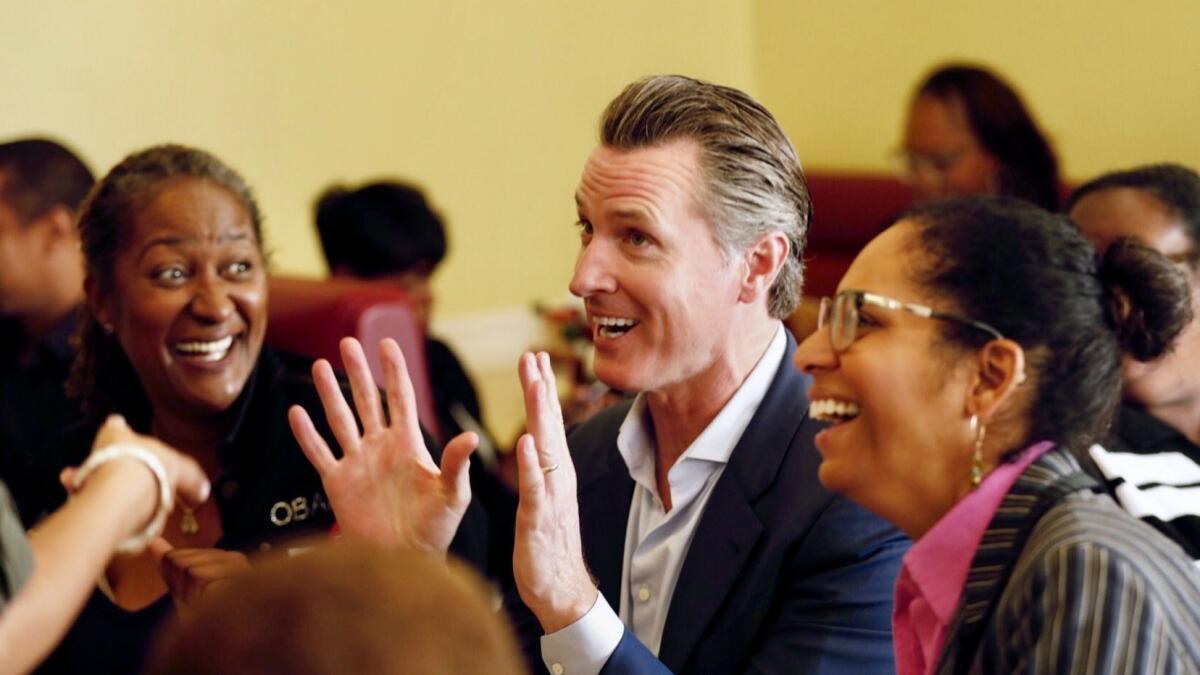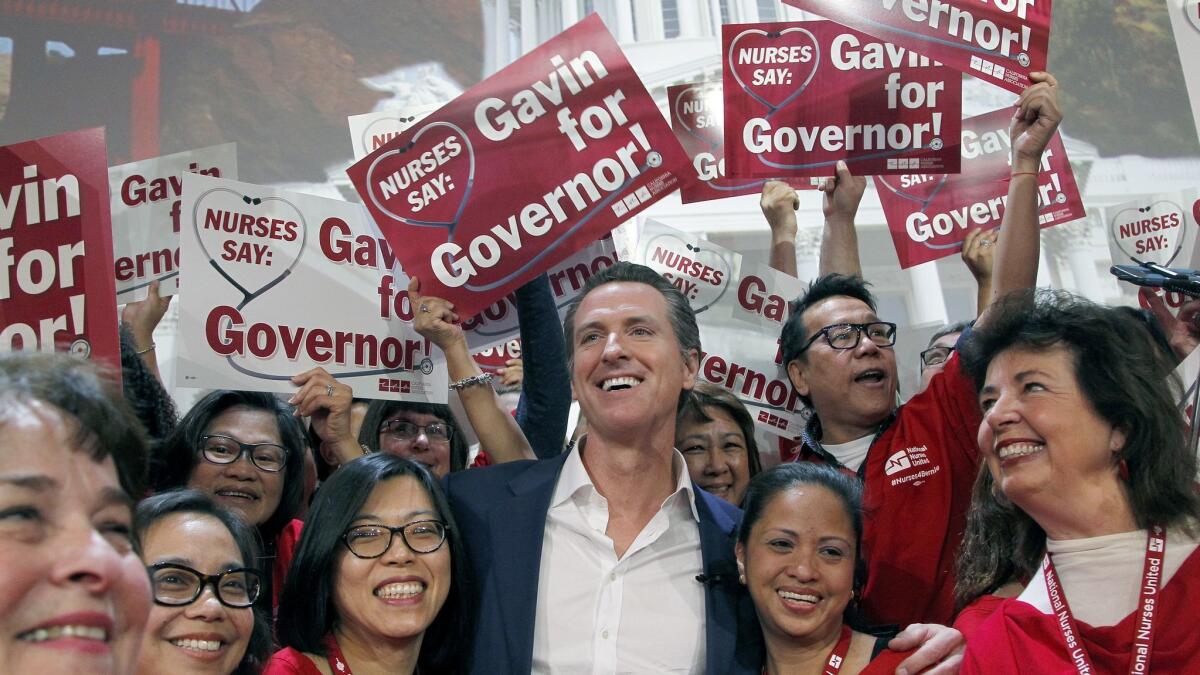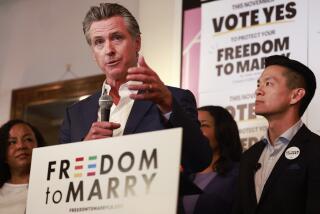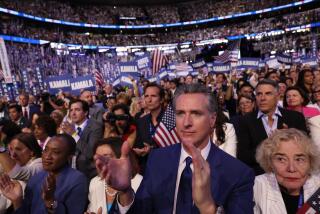It can’t get much better for Gavin Newsom as California’s next governor. But it’s almost certain to get worse

Reporting from Sacramento — Within an hour of being elected California’s 40th governor, Gavin Newsom cast the occasion as not just a win, but a watershed.
“As Californians, we’ve been granted the extraordinary opportunity to write history’s next chapter,” he told supporters on election night, with the ornate former Los Angeles Stock Exchange as a backdrop. “And the extraordinary obligation to help every Californian write their own California story — even from the darkest of circumstances.”
The soaring rhetoric was fitting for a man who had campaigned in all-caps and boldface, offering lofty promises to tackle healthcare, housing and other obstinate problems facing the state.
Now, he’ll have to deliver.
When Newsom is sworn in as governor on Monday, he’ll do so with the wind at his back: a robust state economy and flush budget, a forceful electoral victory and a Capitol brimming with Democratic allies. With that good fortune comes great expectations for success, brought on by Newsom’s “something for everyone” campaign that left key constituencies hungry for follow-through.
It can’t get much better for Newsom, and it’s almost certain to get worse. An economic contraction, a natural disaster, a rebellion among Democratic lawmakers — all threaten the incoming governor’s footing.
“All governors have to be somewhat fatalistic,” said former Gov. Gray Davis, who started his term in 1998 riding the dot-com boom and ended it in 2003 after he was recalled after the state’s energy crisis. “Your fate is not entirely in your hands.”

‘You’ll hold me accountable’
California progressives were euphoric following the November election and ascent of Newsom, who ran an unabashedly liberal campaign for the state’s top job.
“Today, California voters embraced our agenda — for affordable health care, quality child care, and worker rights, and they rejected the politics of division and hate — in overwhelming numbers,” Roxanne Sanchez, president of SEIU California, the state’s largest labor union, said in an election night statement.
Now, Newsom’s allies are waiting to see whether his sweeping vows to build more houses, protect the environment and expand social services for the state’s youngest and oldest will result in actual investment — in state dollars and political capital.
Perhaps the one constituency that does not hold sky-high hopes for the incoming governor is the business community, which harbors fears that his pledges could explode state spending and require new taxes.
But Newsom has also taken pains to cast himself as a friend to industry, pointing to a multimillion-dollar hospitality venture as a sign of his entrepreneurial bona fides.
“He’s got legitimate businesses in this state, and I’ve heard him say more than once to groups that he was mindful of how taxes and regulations can drive up costs,” said Cassandra Pye, a political strategist and former deputy chief of staff to Gov. Arnold Schwarzenegger, who succeeded Davis.
Expectations are particularly high for what the governor-elect will do about healthcare, which Newsom described on the campaign trail as an animating passion. He has pledged nothing short of an overhaul, with goals of expanding coverage, tamping down on prices and ensuring widespread access. But Newsom has been publicly coy on how, exactly, he would achieve those aims.
The focus on healthcare earned him the backing of a varied group of prominent players in the field, including healthcare providers, insurance companies and labor unions worried about cost. But those supporters have diametrically opposed views on what they want to see in a new healthcare system.
For the California Nurses Assn., which endorsed Newsom for governor in 2015, the governor-elect’s swearing-in means a fresh chance at accomplishing its top priority: single-payer healthcare.
“We expect the governor-elect to deliver on his promise: Medicare for All for all Californians,” said Stephanie Roberson, the union’s government relations director.
Newsom previously sided with the nurses in their push for 2017 legislation to establish a single-payer system. When Assembly Speaker Anthony Rendon (D-Paramount) tabled the measure, Newsom said he thought the bill should continue through the legislative process to fill in key details, such as how to pay for it. One legislative estimate pegged the price tag at around $400 billion.
In a meeting with the nurses union after the election, Newsom reiterated his support, Roberson said, telling the group that he would sign a Medicare for All-style bill if it reached his desk. But Roberson acknowledged that Newsom has close ties to other healthcare players — including the physicians’ lobby — that staunchly oppose that approach.
“We’re not Pollyanna-ish about all of the different groups and all of the different entities that are speaking to the governor,” Roberson said. “At the end of the day, the end product is what he’s committed to — and that’s single-payer.”
But such a proposal would face pushback from another major Newsom backer, the California Medical Assn.
“The notion that he’s going to come in and do the single-payer thing, that’s where people need to check themselves,” said Dustin Corcoran, who leads the physicians’ group. “We should challenge ourselves. We should be creative. We should be ambitious — but anchored in pragmatic reality of what we can get done.”
The price tag, coupled with a need for cooperation from the federal government, poses major barriers to the single-payer model, Corcoran said. The doctors lobby argued last year that the nurses’ proposal would drive physicians out of the state or into retirement, and lead to longer wait times for appointments and procedures. Instead, doctors expect the healthcare conversation in the Capitol to focus on a more achievable outcome: improving access to care.
Should Newsom decide to pursue an overhaul of healthcare, it will require a herculean feat of consensus-building — or inevitable disappointment for at least one faction of supporters.
Since he was elected, Newsom has tried to temper expectations on healthcare and other promises. Californians should not expect homelessness to be eradicated, the healthcare system’s ills cured and an end to the housing crisis “overnight,” Newsom said during a December town hall forum in Fresno.
“It’s a process that will unfold over a course of years,” he told reporters after the event. “But I wanted to set a tone and tenor of expectation, and I’m going to do my best to meet it. Some areas I imagine we’ll exceed it. Some areas we’ll fall short. And you’ll hold me accountable.”
‘The incoming governor has a mandate’
Newsom secured nearly 62% of the vote in his race against Republican John Cox, the largest electoral win for a California governor since Earl Warren in 1950. He racked up commanding margins in urban hubs such as Los Angeles and San Francisco, narrowly led in the former GOP stronghold of Orange County and had respectable — if not outright majority — showings in the conservative-leaning Central Valley.
His win overlapped with victories for liberals up and down the ballot, resulting in Democrats building a supermajority — and then some — in both houses of the state Legislature.
“The incoming governor has a mandate,” Pye said. “He’s got a very good Legislature, but he’s got a long list of promises to keep.”
All governors must navigate the power-sharing dynamic with the legislative branch, deciding how proactive they can be in pursuing their agenda versus reacting to the cascade of policy proposals from legislators.
“He’ll have to make a decision about when to engage and when not to engage,” said Dana Williamson, a former top advisor to Gov. Jerry Brown. “Both of those are strategic decisions.”
Brown almost never publicly weighed in on pending legislation, Williamson noted, adding that when he did, “it was very purposeful.” The effect was a tightly curated list of priorities that both voters and lawmakers could easily grasp.
“If you do too much, you can dilute the strength of your message,” she said.
Still, Williamson said she expects Newsom to be more engaged with legislators than Brown.
Brown was largely seen as being able to coax or bend lawmakers to his will, but legislators are eager to reset the power dynamic on more equitable terms.
“The Legislature’s going to be quite a challenge,” Brown said in a recent interview. “And it’s going to be a challenge because, first of all, I’ve been reasonably successful. And there is inherent tension between the executive and the legislative [branches].”
And while Brown was the elder statesman in the Capitol, having served his first two terms as governor decades prior, now it’s the legislators, serving under longer term limits, who collectively have more experience than the state’s new chief executive.
“As [Newsom] prioritizes, he’s going to have to negotiate with a Legislature that is now more powerful than ever,” said Fabian Núñez, the former Assembly speaker. Leaders in both houses “have years of experience in negotiating budgets under their belt. Obviously, Gov. Newsom does not.”
But a Capitol teeming with Democrats does not guarantee a glide path for liberal policies. Democratic victories in more moderate or conservative areas of the state were likely a reflection of the national political dynamic, Davis said, and not necessarily a mandate for progressivism.
“A lot of Republican women decided to vote Democratic...because they couldn’t stand Trump,” Davis said. “Does that mean they’re going to vote Democratic the rest of their life? It’s a mistake to assume they will.”
One advantage for Newsom: The sheer number of Democratic votes means less arm-twisting on tough bills.
Chris Tapio, a consultant to business-friendly Democrats in the Legislature, said the dynamic gives members in swing districts more freedom to lay off tax increases that might not sit well with their constituents. But if progressive lawmakers and Newsom pull too far left, centrist Democrats may take heat for the party’s liberal policies, even if they didn’t personally endorse the bills.
“Sometimes, regardless of a legislator’s position, there’s a guilt by association,” Tapio said.
Pye suggested Newsom’s best strategy may be to strike quickly.
In his first months in office, Schwarzenegger delivered a campaign promise to reduce the vehicle license fee in California to 0.65%, a move critics cast as a grievous financial mistake for the state. He also signed a bill in his freshman year to overhaul the state’s workers’ compensation system, cutting back costs for employers.
Those opposed to the policies were caught off guard by how quickly the plans came together, Pye said.
“I think there’s something to be said for coming into office and getting a big win, and leveraging that moment,” she said. “It helps you establish yourself with the Legislature and with interest groups that are floating around the Capitol. It helps you garner that press you need in case you make a run for national office.”
For his first major policy proposal, Newsom is moving expeditiously to tackle a campaign promise with little political downside and wide support among California voters. The governor, who underscored his call for universal preschool in the final days of his bid for office, unveiled last week a nearly $2-billion proposal to expand access to early education and child-care programs.
‘It’s going to be a mess’
Unlike his predecessor, Newsom won’t be greeted with dire fiscal conditions. He will take office after nearly a decade of nationwide economic expansion and with a healthy budget surplus.
The Legislative Analysts Office in November declared that California’s budget outlook is in “remarkably good shape,” estimating the state will see $14.5 billion in extra revenue, even after it socks away money in the state’s rainy day fund.
“It is difficult to overstate how good the budget’s condition is today,” the report stated. “By historical standards, this surplus is extraordinary.”
But the report cautioned that California’s budget conditions can change quickly, especially if the country spins into another recession. Back in 2000, the state also predicted a massive surplus. Then the dot-com bust arrived. Within a year, California faced a $12.4-billion deficit.
Brown has spent years prophesying that economic doom looms on the horizon, in part to keep spendthrift Democrats in the Legislature in check and also because history shows an eventual downturn is inevitable.
“What’s out there is darkness. Uncertainty. Decline and recession,” Brown said after unveiling his final budget last year. “So good luck, baby!”
Economist Christopher Thornberg, founding partner of Beacon Economics, is bullish on California’s economic outlook in the near term, saying all signs point to continued growth. But he expects a mild recession to hit at some point, saying it will deliver a devastating gut-punch to the state budget — even with $15 billion in state’s reserves — and Newsom’s ambitious policy agenda.
“Even with a modest downturn, you’re going to have two years of $30-billion-plus deficits,” Thornberg said. “It’s going to be a mess.”
California’s overwhelming reliance on personal income tax, including taxes on capital gains, makes the state’s revenue stream volatile. The highest earners provide a lopsided portion of the state’s personal income tax revenue, so when they do well, the state does well. When their investments tank, so does the state’s revenue.
Chris Hoene, executive director of the California Budget and Policy Center, said the volatility can be dealt with if the state’s political leaders have the fiscal discipline to save money in good times, when there are surpluses, knowing that bad times are inevitable.
“The goal should not be reducing volatility, because that means you make the system less fair,” Hoene said. “Managing volatility is the problem. You need people who will make tough choices.”
Economic uncertainty can wreak havoc on a governor’s standing with voters.
“When people feel their lives are getting better, they’re happy to support the incumbent governor. When they feel the opposite, they’re happy to oppose him,” Davis said.
In all, the charmed circumstances under which Newsom is taking office belie the difficult road ahead.
“I think this is going to be as tough as the Dickens,” Pye said. “This is a really tough state to run, and we have a lot of big problems right now. All of that coupled with the question of who will pay for it, you can’t do anything but wish him luck and pray for him.”
Coverage of California politics »
[email protected] | Twitter: @melmason
[email protected] | Twitter: @TarynLuna
[email protected] | Twitter: @philwillon
More to Read
Get the L.A. Times Politics newsletter
Deeply reported insights into legislation, politics and policy from Sacramento, Washington and beyond. In your inbox three times per week.
You may occasionally receive promotional content from the Los Angeles Times.













